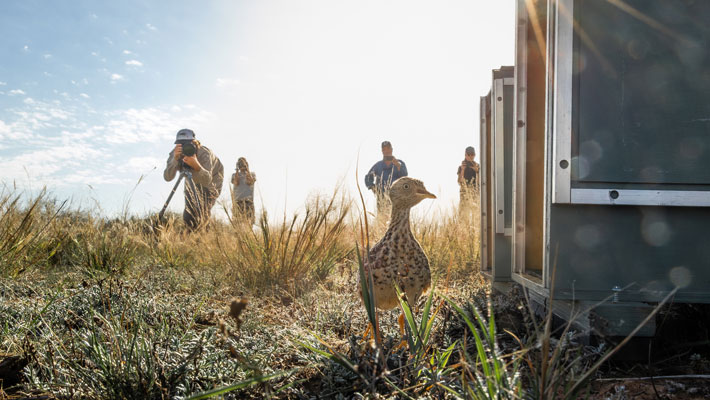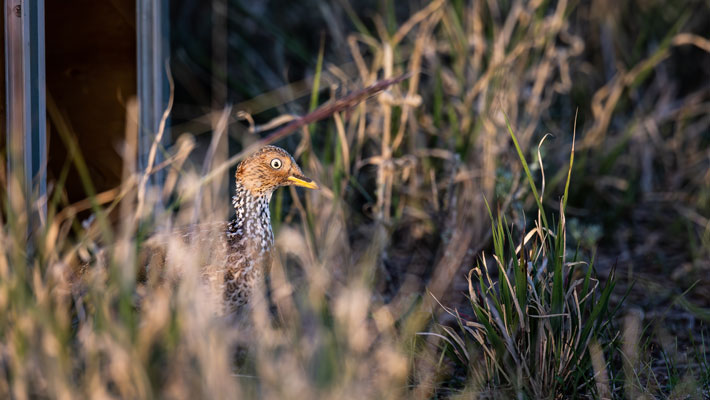Posted on 29th May 2023 by Media Relations
A cohort of critically endangered Plains-wanderers have been released in NSW in a further milestone for the collaborative project aimed at saving the species from extinction.
The 19 so-called “Goldilocks birds” were released onto farmland in the Hay Plains over several days. Twelve of the birds were bred at Taronga Western Plains Zoo in Dubbo, and seven at Werribee Open Range Zoo in Victoria.
Department of Planning and Environment (DPE) Senior Threatened Species Officer, David Parker said it was part of a three-year trial.
“These trial releases of zoo-bred birds are helping to inform future plans for this delicate and completely unique species, part of the wider program that includes actively managing threats like fox predation and maintaining ideal habitat condition,” Mr Parker said.


Co-ordinated by NSW DPE through the Saving our Species program, the birds were released onto properties with suitable habitat conditions and populations of wild Plains-wanderers.
The NSW Riverine Plain is the national stronghold for the species with only around 2,500 birds in the wild.
The released birds were carefully selected and underwent rigorous health checks to determine their fitness ahead of their release. This included examination under anaesthesia of body weight and body condition, general physical examination, blood tests, fitting of leg bands for individual identification purposes and fitting of transmitters for post-release monitoring.
“When conducting pre-release checks we are looking for any signs of injury or illness and checking that the birds are in good physical condition,” Taronga Western Plains Zoo Senior Veterinarian Dr Alisa Wallace said. “Health checks are essential to ensure that each bird is in peak condition to maximise their ability to thrive in the wild.”
Prior to the release the behaviour of all birds was monitored closely in Dubbo and Werribee. Insect scatter feeds were increased to encourage natural foraging, and their zoo homes filled with wild seeds and plants from the release site. Individuals were paired with their release companion to allow bonding ahead of their release.
“On the morning of their departure the birds received a final in-hand veterinary health check of their eyes, wings, mouth, legs and chest, and their transmitter,” Taronga Western Plains Zoo Plains-wanderer Keeper Mark O’Riordan said.
“They were then loaded into purpose-built transport boxes for the drive from Dubbo and Werribee to the release site in the Hay Plains.”
Taronga Western Plains Zoo is thrilled to be playing a key role in this critical program aimed at saving the Plains-wanderer.“Since commencing the conservation breeding program we have all come such a long way in terms of our knowledge of the birds, our understanding of their behaviours and breeding, leading to our most successful breeding season to date here in Dubbo with 17 chicks born this year,” Mr O’Riordan said. “To now see them head off into their natural habitat, it’s what we all work so hard to achieve and so rewarding to be a part of.”
Zoos Victoria Threatened Species Program Coordinator Chris Hartnett said:
“Supporting wild populations with ongoing releases of Plains-wanderers, which are born and raised within zoo conservation breeding programs, is paving the way for the recovery of the species.
“Following previous releases, we’ve observed released birds thriving in the wild and socialising with wild birds. We’re hopeful this multi-state cross-agency conservation initiative can contribute to re-establishing thriving wild Plains-wanderer populations in the future.”
The birds’ new home is on the properties of conservation-focused farmers who have taken up incentive schemes including the Paddocks for Plains-wanderer program as well as the Biodiversity Conservation Trust’s targeted Plains-wanderer tender.
Landholders Bill and Diane Hooke said it’s a win-win on both sides.
“We really want to see these birds flourish and we can manage the grazing patterns to suit their environment and to suit ourselves. It works hand in hand.
“It’s good to put something back to the environment and it’s a real interest for us to do it,” they said.
This research trial involves the NSW Department of Planning and Environment, Taronga Conservation Society Australia, NSW National Parks and Wildlife Service the Murray and Riverina Local Land Services, Zoos Victoria, the Victorian Department of Energy, Environment and Climate Action, Parks Victoria, Trust for Nature, Zoos South Australia and private landholders. The program receives funding through the NSW Government’s Saving our Species program, National Landcare Program, Biodiversity Conservation Trust, Taronga Conservation Society Australia, Zoos Victoria and their supporters.
About the Plains-wanderer
The Plains-wanderer is a small quail-like ground dwelling bird standing about 12 – 15cm tall and weighing about 40 – 95 grams. Both sexes have straw-yellow legs and bills, and their plumage is mainly fawn with fine black rosettes. The larger female is easily distinguished by her prominent white-spotted black collar above a rich rufous breast patch.
The Plains-wanderer is classified as an EDGE species (Evolutionary Distinct and Globally Endangered) through the EDGE of Extinction program which highlights and protects the most unique species on the planet which are on the verge of extinction. The Plains-wanderer features as #1 Bird on the EDGE list because of its high extinction risk and evolutionary uniqueness. The species has experienced a decline of >90% since 2001 in both its population strongholds in the NSW Riverina and in Northern Central Victoria.
The ongoing management of habitat across the species range is also a critical part of this program. Across the species range, particularly in New South Wales and Victoria, private landowners and managers are working with government and not-for-profit organisations to protect the species native grassland habitat. Collectively, the work being done by all project partners aims to remove this species from the critically endangered list.